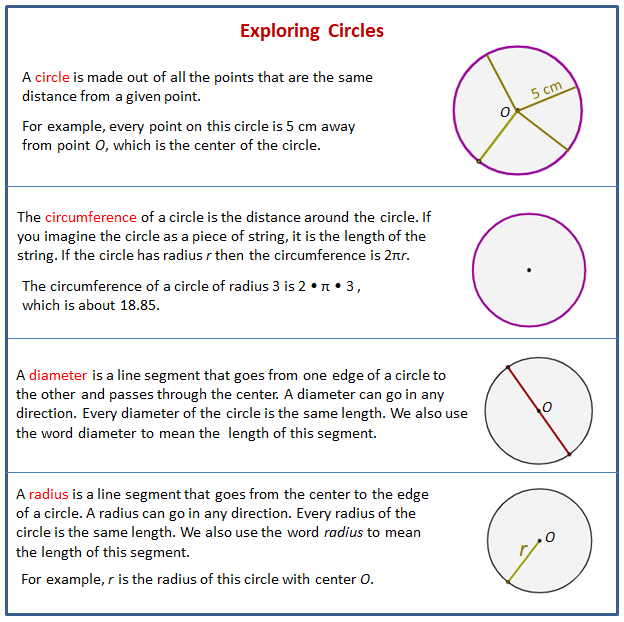Illustrative Mathematics Grade 7, Unit 3, Lesson 2: Exploring Circles
Learning Targets:
- I can describe the characteristics that make a shape a circle.
- I can identify the diameter, center, radius, and circumference of a circle.
Related Pages
Illustrative Math
Grade 7
Lesson 2: Exploring Circles
Let’s explore circles.
Illustrative Math Unit 7.3, Lesson 2 (printable worksheets)
Lesson 2 Summary
The following diagram shows how to identify the diameter, center, radius, and circumference of a circle.

Lesson 2.1 How Do You Figure?
Here are two figures.
Figure C looks more like Figure A than like Figure B. Sketch what Figure C might look like. Explain your reasoning.
Lesson 2.2 Sorting Round Objects
Your teacher will give you some pictures of different objects.
- How could you sort these pictures into two groups? Be prepared to share your reasoning.
- Work with your partner to sort the pictures into the categories that your class has agreed on. Pause here so your teacher can review your work.
- What are some characteristics that all circles have in common?
- Put the circular objects in order from smallest to largest.
- Select one of the pictures of a circular object. What are some ways you could measure the actual size of your circle?
Are you ready for more?
On January 3rd, the Earth is 147,500,000 kilometers away from the Sun. On July 4th, the Earth is 152,500,000 kilometers away from the Sun. The sun has a radius of about 865,000 kilometers.
Could the Earth’s orbit be a circle with some point in the Sun as its center? Explain your reasoning.
-
Show Answer
The diameter of the circle would be 147,500,000 + 152,500,000 + 865,000 = 300,865,000
The radius of the circle would be 300,865,000 ÷ 2 = 150,432,500 km.
Lesson 2.3 Measuring Circles
Priya, Han, and Mai each measured one of the circular objects from earlier.
Priya says that the bike wheel is 24 inches.
Han says that the yo-yo trick is 24 inches.
Mai says that the glow necklace is 24 inches.
- Do you think that all these circles are the same size?
- What part of the circle did each person measure? Explain your reasoning.
Lesson 2.4 Drawing Circles
Spend some time familiarizing yourself with the tools that are available in this applet.
Show Applet
Draw and label each circle.
Circle A, with a diameter of 6 cm.
Circle B, with a radius of 5 cm.
Circle C, with a radius that is equal to Circle A’s diameter.
Circle D, with a diameter that is equal to Circle B’s radius. Pause here so your teacher can review your work.
Use a compass to recreate one of these designs.
Lesson 2 Practice Problems
- Use a geometric tool to draw a circle. Draw and measure a radius and a diameter of the circle.
- Here is a circle with center H and some line segments and curves joining points on the circle.
Identify examples of the following. Explain your reasoning.
a. Diameter
b. Radius - Lin measured the diameter of a circle in two different directions. Measuring vertically, she got 3.5 cm, and measuring horizontally, she got 3.6 cm. Explain some possible reasons why these measurements differ.
- A small, test batch of lemonade used 1/4 cup of sugar added to 1 cup of water and 1/4 cup of lemon juice. After confirming it tasted good, a larger batch is going to be made with the same ratios using 10 cups of water. How much sugar should be added so that the large batch tastes the same as the test batch?
- The graph of a proportional relationship contains the point with coordinates (3,12). What is the constant of proportionality of the relationship?
The Open Up Resources math curriculum is free to download from the Open Up Resources website and is also available from Illustrative Mathematics.
Try out our new and fun Fraction Concoction Game.
Add and subtract fractions to make exciting fraction concoctions following a recipe. There are four levels of difficulty: Easy, medium, hard and insane. Practice the basics of fraction addition and subtraction or challenge yourself with the insane level.

We welcome your feedback, comments and questions about this site or page. Please submit your feedback or enquiries via our Feedback page.